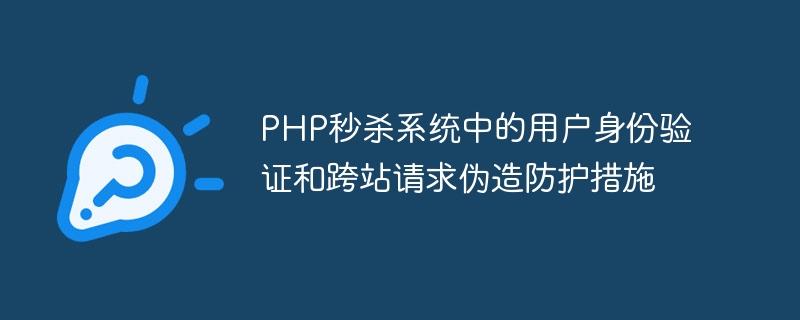Home >Backend Development >PHP Tutorial >User authentication and cross-site request forgery protection measures in PHP flash kill system
User authentication and cross-site request forgery protection measures in PHP flash kill system
- WBOYWBOYWBOYWBOYWBOYWBOYWBOYWBOYWBOYWBOYWBOYWBOYWBOriginal
- 2023-09-21 10:30:111150browse

Title: User Authentication and Cross-site Request Forgery Protection Measures in PHP Flash Kill System
Introduction:
In today's Internet era, e-commerce platforms and websites Often faced with a large number of user access and request impact. In order to ensure fairness and security, the flash sale system came into being. However, flash sale systems themselves present some security risks, particularly user authentication and cross-site request forgery (CSRF) attacks. This article will discuss how to implement effective user authentication and CSRF protection in PHP.
1. User authentication:
User authentication is the most important part of the flash sale system. It is used to confirm the user's identity and permissions and prevent malicious operations by malicious users and robots. The following are some common user authentication methods:
- Username and Password Verification:
When users register in the flash sale system, they must provide a unique username and password. When the user logs in, the system will check whether the entered user name and password are consistent with those saved in the database. The following is a simple implementation example:
// 用户登录处理
function login($username, $password) {
// 首先从数据库中获取该用户名对应的密码
$db_password = getPasswordFromDatabase($username);
// 对比输入的密码和数据库中保存的密码是否一致
if (md5($password) == $db_password) {
return true;
} else {
return false;
}
}- Verification code:
To prevent robots and malicious users from brute force cracking of passwords, you can add a verification code to the login page. Users need to enter the correct verification code to continue logging in. The following is an example of using the GD library to generate a verification code:
// 生成验证码
function generateCaptcha() {
$captcha = imagecreatetruecolor(100, 30);
$bg_color = imagecolorallocate($captcha, 255, 255, 255);
$text_color = imagecolorallocate($captcha, 0, 0, 0);
// 在验证码上绘制随机数字
$code = rand(1000, 9999);
imagestring($captcha, 5, 40, 10, $code, $text_color);
// 将验证码保存到会话中
$_SESSION['captcha'] = $code;
// 输出验证码图像
header('Content-Type: image/png');
imagepng($captcha);
imagedestroy($captcha);
}
// 验证验证码
function verifyCaptcha($input_code) {
if ($_SESSION['captcha'] == $input_code) {
return true;
} else {
return false;
}
} 2. Cross-site request forgery protection:
CSRF is a method that uses the user's identity to conduct illegal activities without their knowledge. The requested attack method. To prevent CSRF attacks, you can take the following measures:
- Add a random token:
Add a randomly generated token to each form and store it in the session or cookie. When the user submits the form, the system checks to see if the token in the form matches the token in the session or cookie. The following is a sample code:
// 生成并存储令牌
function generateToken() {
$token = md5(uniqid(rand(), true));
$_SESSION['token'] = $token;
return $token;
}
// 输出包含令牌的表单
function printForm() {
$token = generateToken();
echo '<form action="submit.php" method="POST">';
echo '<input type="hidden" name="token" value="' . $token . '">';
echo '<input type="submit" value="Submit">';
echo '</form>';
}
// 验证令牌
function verifyToken($input_token) {
if ($_SESSION['token'] == $input_token) {
return true;
} else {
return false;
}
}- Verification source:
On the server side, you can check whether the source of the request is consistent with the domain name of the current web page. The following is a sample code:
function verifyReferer() {
$referer = $_SERVER['HTTP_REFERER'];
$host = $_SERVER['HTTP_HOST'];
if ($referer != $host) {
return false;
} else {
return true;
}
}Conclusion:
In the PHP flash killing system, user authentication and CSRF protection measures are very important security measures. By effectively verifying user identity and preventing CSRF attacks, the security and user experience of the system can be improved. The above code examples are only part of the basic implementation, and specific practical applications need to be modified and improved according to their own needs.
The above is the detailed content of User authentication and cross-site request forgery protection measures in PHP flash kill system. For more information, please follow other related articles on the PHP Chinese website!

